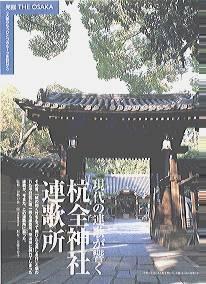Hirano Renkasho 杭全神社・連歌所
(Rengasho)
At the shrine Kumata Jinja there is a special hall for Renga Meetings (renku, renka , Linked Verse). Matsuo Basho spend some time in the area and used to held meetings in this hall. It has two rows of elevated platforms for the participants to sit on and above them are old paintings of famous Japanese poets.
Basho also taught Renku at the Tenmangu shrine Rengasho in Osaka. This building is lost today.
大坂天満宮連歌所の宗匠.
The tradition of Renku is revived now and the townspeople of Hirano, an old merchant district with many surviving traditional stores, especially the rich merchants, gather to enjoy a poetry session to this day. I saw a program on TV in September 2005 showing this hall. There are chronicles from the Kamakura period referring to the poets gatherings at this hall. The Kumata shirne itself dates back to the Heian period.
There used to be such halls in many other shrines in Osaka, but they were all lost in the course of time. This one seems the only one surviving and acitve to our day.
The hall is in the compound of the Kumata shrine, sourrounded by some trees older than 600 years old giving shade in the hot summer days. There are also many bushclovers (hagi) to be enjoyed in Autumn.
Gabi Greve
:::::::::::::::::::::::::::::::::::::::::::::::::::::::::::::::::::::::::::::::::::::::::::::::::::::

杭全神社 / 連歌所
「杭全神社連歌所記」によれば、当社の連歌は鎌倉時代に始まり、坂上家の後裔と称する平野七名家を中心として室町時代に盛んになったという。中世以来の連歌所は慶長19年(1614)、大坂冬の陣の際に破却された。現存する連歌所は宝永5年(1708)に再建されたものである。
現在の連歌所は桁行4間半・梁行2間半、入母屋造り本瓦葺きで、12畳の主室と4畳の控の間があり、控の間の西側が玄関となっている。主室の東側に半間の縁側、控の間の南側に半間の濡縁がつく。主室の北側正面は、中央1間を「床」、その東側を収納スペースとしているが、この部分はもとは西側と同様に半蔀窓であった。西側に間口1間半の玄関が連続する。
連歌所は大阪府下でも菅原神社(堺市 1666年以前)、佐田天満宮(守口市 1759年以前)、大阪天満宮(1793年以前)、住吉大社(1860年以前)、開口神社(堺市 1860年以前)などに存在したが、現存する建物としては、全国的にみても極めて少ない。簡素な中に気品があり、近世連歌所として極めて重要な建築物といえる。
平野七名家: 七名家は坂上氏の同族と称する、土橋・三上・辻葩などの各氏を言う。この七家が中心となって堺と並ぶ自治都市を築いた。
濡縁: 雨戸の敷居の外側に付けられた縁。
半蔀窓: 蔀は光線・風雨を防ぐ建具で、格子の裏に板を貼ったもの。半蔀は上下2段に分かれたものであり、開ける時にはこのうち上1枚を金具で水平に吊り上げる。
http://www.city.osaka.jp/kyouiku/sikumi/bunkazai/bunkazai03_11_02.html
:::::::::::::::::::::::::::::::::::::::::::::::::::::::::::::::::::::::::::::::::::::::::::::::::::::
Bushclover at the Mata shrine 連歌所碑前

http://www.kumata.jp/oshirase/hagi/hagi16-10-15.html
:::::::::::::::::::::::::::::::::::::::::::::::::::::::::::::::::::::::::::::::::::::::::::::::::::::

その昔「城の如く竹をもって囲ひたる美しき村」
と唱われた平野区に唯一残る連歌所。
http://www.osaka-cpa.or.jp/html/syuppan/soft/soft304.html
:::::::::::::::::::::::::::::::::::::::::::::::::::::::::::::::::::::::::::::::::::::::::::::::::::::
杭全神社・連歌所
当社は坂上田村麿(さかのうえのたむらまろ)の子、広野麿(ひろのまろ)の息子当道(とうどう)が氏神として素盞嗚(すさのお)命を崇神としたのが最初という。本殿は三殿からなり、第二・三殿は永正(えいしょう)10年(1513)室町時代中期でいずれも重要文化財指定をうけている。
境内の連歌所(れんかしょ)は、大坂冬の陣のとき壊されたが宝永5年(1708)再興された。連歌は平安時代に発生したが、ここは公卿との縁故も深かったので盛んに行われ、連歌は神事として年中行事になっていたが、最近復活された。これからも中世における杭全庄の文化活動の一端が偲ばれる。
また境内にはくすの大樹が多く、樹齢600年以上と思われるものが大阪府天然記念物に指定されている。
http://www.road.osaka-city.or.jp/orc/rekishi/imahira/p19.htm
:::::::::::::::::::::::::::::::::::::::::::::::::::::::::::::::::::::::::::::::::::::::::::::::::::::
Main Page of Kumata shrine (in Japanese)
http://www.kumata.jp/
Map of the buildings
http://www.kumata.jp/keidai/keidaizu.html
The building Nr. 18 is the Renka Hall.
:::::::::::::::::::::::::::::::::::::::::::::::::::::::::::::::::::::::::::::::::::::::::::::::::::::
Read my story about
Basho and Haiku 松尾芭蕉の俳句 Matsuo Basho (Matsuo Bashoo)
************************
Please send your contributions to Gabi Greve
http://groups.yahoo.com/group/Darumasan-Japan/








No comments:
Post a Comment